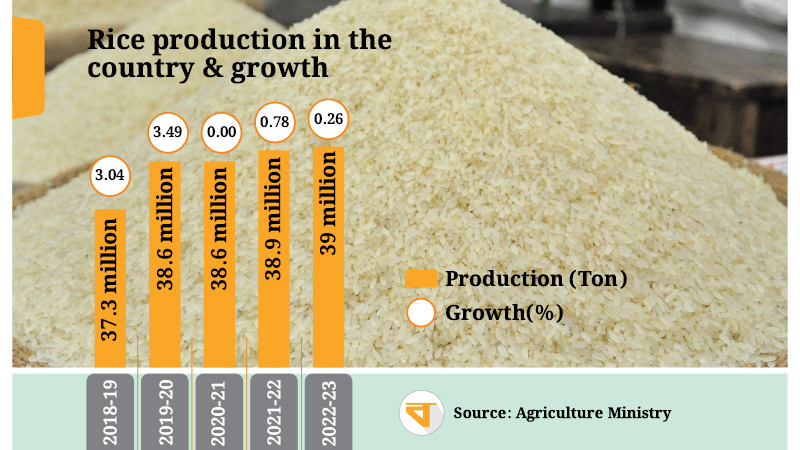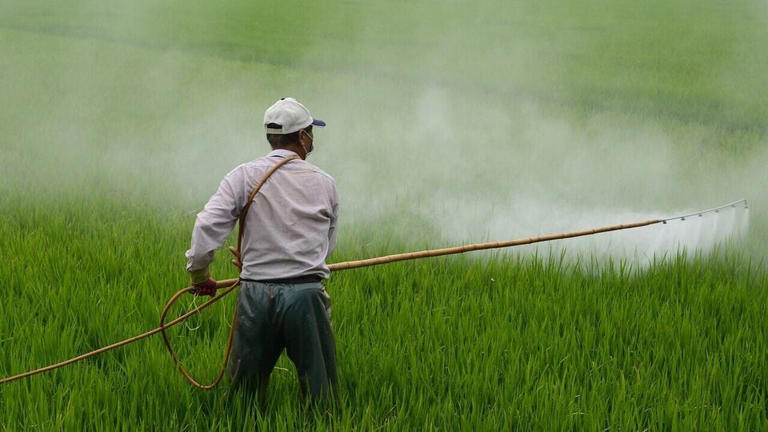Tags
Rice productivity not enhancing as expected
Experts blame increased production cost, reduction of farmland and slow pace of automation
Eiahia Nakib

In order to ensure food security for a growing population, the government has set a target to double the rice productivity by 2030 as compared to 2015. Despite taking different initiatives, the production cannot be enhanced as expected. Even worse, the growth rate of rice has now gone down below the annual rate of population increase. According to information detailed in ‘Sample Vital Statistics – 2023’ compiled by Bangladesh Bureau of Statistics (BBS), the rate of natural increase (RNI) of population in the country in 2023 was 1.33 percent. This was 1.4 percent in 2022. As per the census, the average population growth rate was 1.12 percent. But, analyzing the data of Agriculture Ministry, it was found that growth of rice production in last three fiscal years was below 1 percent.
For the slow pace of growth in rice production, experts put the blame on reduction of cultivable land and non-inclusion of new workforce in the agriculture sector. They are of the opinion that structural changes are taking place rapidly in the agriculture sector. Arable land is declining. People are leaning to other crops due to production cost increase and absence of the right price of paddy. And, the pace of automation in agriculture is being slowed down owing to the instability with respect to exchange rate of dollar. Due to this volatility, people are not being able to take the advantage of the automation. Under such a situation, many are giving up on agriculture.
The country produced 38.6 million tons of rice in 2020-21 fiscal year, according to the Ministry of Agriculture. Same amount of rice was produced in the previous fiscal. That means the growth rate was zero. In 2021-22 fiscal, the rice production was 38.9 million tons, an increase of 0.78 percent. In 2022-23 fiscal, the rice production went up by only 0.26 percent to 39 million tons. The production each year was below target.
It will not be possible to achieve expected rice production without providing subsidy and incentives alongside automation of agriculture, believes agricultural economist Dr Jahangir Alam Khan. “The import cost of machineries has gone up due to high price of dollar. As a result, the pace of automation is slow. It should be made faster. The production cost of paddy is on the rise. So is the irrigation cost. About 65 percent farmers still depend on petrol for irrigation. So, subsidy will have to go up here,” he told Bonik Barta.
Bangladesh Agricultural University Emeritus Professor Dr MA Sattar Mandal feels that the target of production of rice cannot be achieved due to reduction of farmland and disinterest in agriculture among the youths in the country. He even cast doubt about doubling the production by 2030.
Talking to Banik Barta on Thursday, he said, “The arable land in the country is decrease every year at the rate of 0.5 percent. The number of farmers is declining due to lack of interests of the youths. As a result, achieving the target to double the rice production has become challenging. However, there are new technologies in the sector along with new varieties. Young entrepreneurs are getting engaged in fishing and other crops. Keeping export in mind, they are farming potato, maize, wheat, tomato and other crops. Sesame or mustard are cultivated instead of green crops. Does it mean that we will import rice exporting our cash crops? Maybe, young people will enter commercial agriculture. But, they will not cultivate paddy. Marginal farmers will somehow survive to feed themselves. As a result, the production of rice will not increase to meet the target.”
The devaluation of taka against dollar has made the agricultural automation even more expensive. According to people concerned, it possible to reduce the production cost to a significant extent alongside increasing the productivity through the automation. But, at present, the price of agricultural machineries has gone up due to increased import cost of appliances and spare parts. As a result, it is difficult for the farmers to get hold of these machineries even if they want to.
ACI Agribusiness President Dr FH Ansarey believes that the price hike of agricultural machineries is making farmers uninterested in automation. “Due to increased exchange rate of dollar, the price of a single harvesting machine has risen to Tk 4.2 million. Even after subsidy, it is extremely difficult for a farmer to manage Tk 2 million. Using machine, it costs Tk 18-20 to produce a kilogram of paddy while it costs Tk 30 in conventional method. Farmers will require 80 percent subsidy if the production cost is to be reduced through automation. At this, use of machineries will increase and production cost will go down,” he told Bonik Barta.
Bangladesh Rice Research Institute (BRRI) is working on doubling the production of paddy by 2030. On the occasion of Mujib Centenary Year, the organization formulated a strategic paper titled ‘Doubling Rice Productivity’. According to the paper, it is possible to produce 46.9 million tons by 2030 after doubling the productivity.
BRRI Director General Dr M Shahjahan Kabir claims that only rice production is in a comfortable position. “Production of potato and other crops went down. But, we are heading towards our target. We hope that the productivity will be doubled before 2030,” he told Bonik Barta.
When contacted, former State Minister for Planning Dr Shamsul Alam, also an agricultural economist, told Bonik Barta, “If farming of paddy cannot be profitable, it will be difficult to hold on to the current productivity. Price of agricultural materials will have to be slashed. Automation should be enhanced. High-quality seeds should be invented.”
Published Date: May 25, 2024






